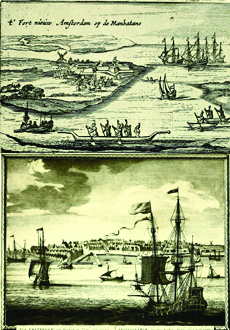The Skyscraper Museum is devoted to the study of high-rise building, past, present, and future. The Museum explores tall buildings as objects of design, products of technology, sites of construction, investments in real estate, and places of work and residence. This site will look better in a browser that supports web standards, but it is accessible to any browser or Internet device.
DUTCH ORIGINS

Top: I. N. Phelps Stokes, The Iconography of Manhattan Island, Volume 1, PL 1.
Retrieved from www.archive.org
Bottom: David T. Valentine, History of the City of New York, 1853, pg. 70.
First "discovered" by Henry Hudson in 1609, the island of Manhattan was explored for the States General of the Dutch Republic between 1611 and 1614 by private commercial companies, most notably the Dutch East India Company. Manhattan was chosen as the optimal location for a permanent settlement of the newly-formed Dutch West India Company, and in 1625, Fort Amsterdam was constructed at the southern tip of the island.
One of the earliest depictions of the Dutch colony, the top image was drawn by surveyor Cryn Fredericksz to show the investors in Amsterdam a vision for the town, rather than its actual layout. The topography of the area is inverted, due, perhaps, to the use of a camera obscura, showing the Fort on what seems to be the east side of the island. Native Americans appear in primitive long boats in contrast to the larger Dutch ships.
Drawn by the well-known 19th century lithographer George Hayward, the lower image shows New Amsterdam from the harbor in 1667, after British forces captured the island. Gabled rooflines cluster along the East River, with a windmill turning in the distance. Streaming inland is a canal that occupied modern Broad Street. A bastion of defense that would eventually become Wall Street can be seen towards the north edge of town at the right side of the image.
